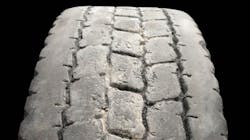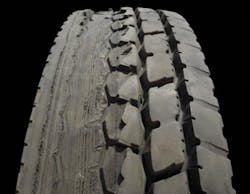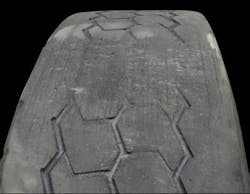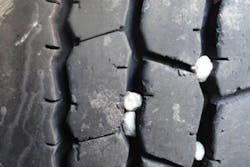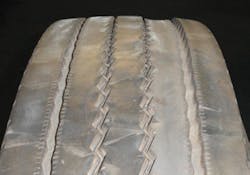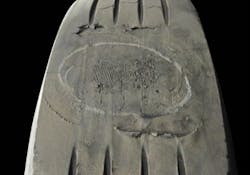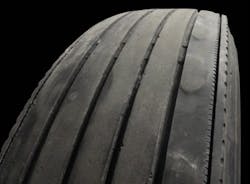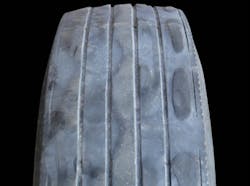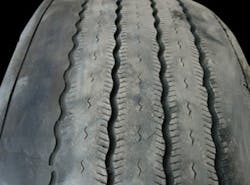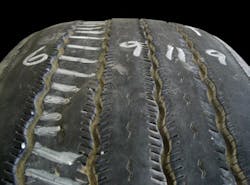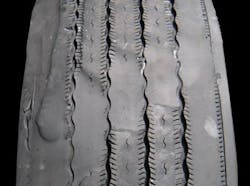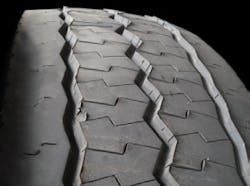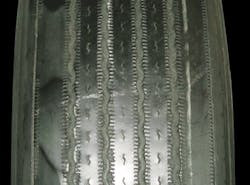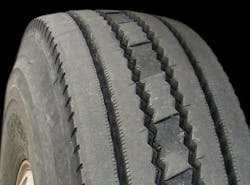The Usual Suspects: Guide to commercial truck tire wear by type
This guide provides various examples of different tire conditions for irregular drive tire, trailer tire and steer tires. Read more and see visuals below on the most common causes and corrective actions for common tire conditions.
Irregular drive tire conditions
(Find more information about on-vehicle tire balancing options here.)
1. Multiple Cuts/Chunking
- Appearance: Numerous small cuts to the tread surface with portions of tread removed, giving a rough appearance.
- Probable Cause: Vehicle operation on rough surfaces (misapplication of tread compound).
- Corrective Action: Review tire selection and operation.
- Tire Disposition: Minor damage should return to service. Consult retreader for possible repair and retread.
2. Vehicle/Spin Damage
- Appearance: Cuts or lines 360 degrees around the tire.
- Probable Cause: Contact with vehicle components (mud flap brackets, bumpers), or spinning the tires on ice or loose road surface.
- Corrective Action: Analyze cause. Ensure tire does not contact vehicle components. Review driver practices.
- Tire Disposition: Return to service if damage is not below base of tread groove.
3. Brake Skid Damage
- Appearance: Localized spot of excessive wear across tread face showing abrasion marks. Damage may extend into casing.
- Probable Cause: New brakes (not worn in), unbalanced brake system, frozen brake lines, driver abuse.
- Corrective Action: Check brake system.
- Tire Disposition: May be repaired or retreaded if casing is undamaged; otherwise, scrap.
4. Stone Retention/Drilling
- Appearance: Stones or gravel imbedded between tread blocks, sometimes reaching steel cables.
- Probable Cause: Condition is common with vehicles operating on gravel surfaces. Over-inflation, misapplication of the tire.
- Corrective Action: Remove stones & return to service. Maintain proper inflation pressures.
- Tire Disposition: Continue to run unless there are multiple spots reaching steel cables. Consult retreader or tire manufacturer.
5. Heel/Toe Wear
- Appearance: Each lug around tire worn high to low from front to back edge.
- Probable Cause: Mismatched inflation pressure or tire diameters in a dual assembly. High torque conditions, mountainous terrains and high inflation pressures aggravate this condition.
- Corrective Action: Review tire maintenance practices. Consult tire manufacturer when selecting tire for operation.
- Tire Disposition: Continue to run. If severe, change direction of rotation.
6. Cupping/Scallop/Alternate Lug Wear
- Appearance: Localized cupped-out areas of fast wear around the tire. Alternate lugs worn to different tread depths around the tire.
- Probable Cause: Mismatched inflation pressure or tire diameters in a dual assembly. Aggravated by slow rate of wear, poorly maintained suspension components.
- Corrective Action: Check for mechanical problem.
- Tire Disposition: Check for worn components, inflation pressures and matching tread depths.
Irregular trailer tire conditions
1. Depression Wear (Intermediate)
- Appearance: One or more interior ribs (not center) worn below adjacent ribs around the tire’s circumference.
- Probable Cause: Worn suspension components, mismatched dual diameter or inflation pressures, underinflation, improper bearing adjustment. Aggravated by high speed/light loads.
- Corrective Action: Diagnose mechanical condition and correct.
- Tire Disposition: Continue to run until pull point, then retread.
2. Diagonal Wear
- Appearance: Localized flat spots worn diagonally across the tread, often repeating around the tire.
- Probable Cause: Improper bearing adjustment, misalignment, mismatched dual tire diameter and/or inflation pressure. May start as brake skid. Aggravated by high speed/light loads.
- Corrective Action: Analyze cause and correct.
- Tire Disposition: Reverse direction of rotation. If excessive, submit for retreading.
3. Brake Skid Damage
- Appearance: Localized spot of excessive wear across tread face showing abrasion marks. Damage may extend into casing.
- Probable Cause: New brakes (not worn in), unbalanced brake system, frozen brake lines, driver abuse.
- Corrective Action: Check brake system.
- Tire Disposition: May be repaired or retreaded if casing is undamaged; otherwise, scrap.
4. Depression Wear (Shoulder)
- Appearance: Localized areas of wear in shoulder, generally less than 12” in length.
- Probable Cause: Improper inflation pressure or tire mis-mounted on wheel. Can also be caused by some other type of wheel-end imbalance.
- Corrective Action: Review tire and wheel-end maintenance practices.
- Tire Disposition: Continue to run until pull point, then retread.
5. Shoulder Step Wear
- Appearance: Tire worn on edge of one shoulder, greater than 12” in circumference.
- Probable Cause: Excessive camber, misaligned or damaged axle, improper bearing adjustment.
- Corrective Action: Diagnose misalignment and/ or mechanical condition and correct.
- Tire Disposition: Reverse direction of rotation. If excessive, submit for retreading.
6. Cupping/Scallop Wear
- Appearance: Random areas of fast wear around the tire. Erratic in some instances.
- Probable Cause: Mismatched inflation pressure or tire diameters in a dual assembly. Aggravated by high speeds/light loads, poorly maintained suspension components.
- Corrective Action: Check for worn components, inflation pressures and matching tread depths.
- Tire Disposition: Continue to run until pull point, then retread.
Irregular steer tire conditions
1. One Sided Wear
- Appearance: Wear increasing from one side to the other.
- Probable Cause: Out of alignment specification parameters (camber, toe, axle parallelism).
- Corrective Action: Check alignment and inspect for worn parts.
- Tire Disposition: Continue to run until minimum tread depth is reached.
2. Shoulder Step Wear
- Appearance: Partial or full depression of the inside or outside shoulder tread rib.
- Probable Cause: This condition is common on radial tires in slow wearing operations.
- Corrective Action: None.
- Tire Disposition: Continue to run or rotate.
3. Erosion/River Wear
- Appearance: Circumferential worn area situated on the sides of the tread ribs.
- Probable Cause: Condition most commonly occurs on slow wearing radial tires in steer or trailer position (free rolling).
- Corrective Action: None.
- Tire Disposition: Continue to run.
4. Depression Wear (Intermediate)
- Appearance: One or more interior ribs (not center) depressed more than adjacent ribs.
- Probable Cause: Incorrect air pressure, worn mechanical part, or non-uniformity such as mismount.
- Corrective Action: Check air pressure and mechanical issues.
- Tire Disposition: Rotate or retread.
5. Diagonal Wear
- Appearance: Manifests in the form of oblique wear patches. Can appear singularly or repeat around the circumference of the tire.
- Probable Cause: Misalignment, radial and lateral runout, severe out of balance, loose wheel bearings or steering parts.
- Corrective Action: Check for mis-mount and worn parts.
- Tire Disposition: Reverse direction of tire or retread.
6. Radial Feather Wear
- Appearance: Feathering at the edge of the tread ribs.
- Probable Cause: Usually the result of continued exposure to lateral force, such as excessive toe. Can also form as a result of counter-steering to compensate for drive axle misalignment.
- Corrective Action: Check alignment.
- Tire Disposition: Rotate to another position or retread.
7. Multiple Flat Spotting Wear
- Appearance: Multiple radially worn areas around the tire.
- Probable Cause: Faulty shocks, loose/worn wheel bearings, severe balance issues, mismatched pressures or tire diameters, excessive high speed empty operation.
- Corrective Action: Check for mechanical issue, check air pressure.
- Tire Disposition: Continue to run or retread.
8. Depression Wear (Shoulder)
- Appearance: Localized wear patch on the shoulder rib of the tire. This patch can repeat around the circumference of the tire.
- Probable Cause: Faulty shocks, lateral runout, loose wheel bearings, mis-mount, severe balance issue.
- Corrective Action: Check for mechanical problem.
- Tire Disposition: Continue to run, rotate or retread.
9. Depression Wear (center)
- Appearance: Circumferential depression wear of the center tread rib.
- Probable Cause: Overloaded/underinflated, faulty shocks, loose wheel bearings, mismount, high speed empty haul conditions.
- Corrective Action: Check air pressures/load weight and worn parts.
- Tire Disposition: Continue to run, rotate or retread.
If you'd like more information and articles like this in your inbox, subscribe to the Fleet Maintenance Today newsletter.
